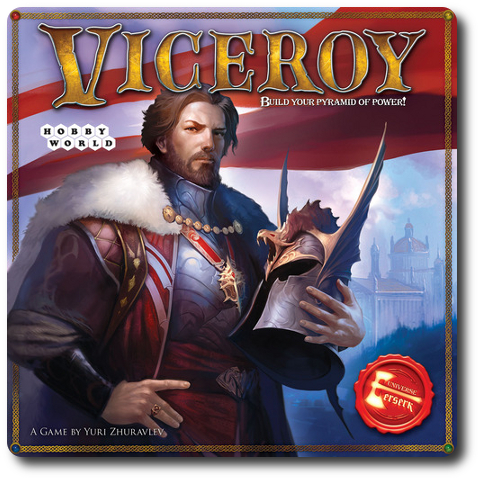
The Basics:
- For ages 8 and up (publisher suggests 13+)
- For 1 to 4 players
- Approximately 45 minutes to complete
Geek Skills:
- Counting & Math
- Logical & Critical Decision Making
- Reading
- Pattern/Color Matching
- Strategy & Tactics
- Hand/Resource Management
- Auctioning & Bidding
Learning Curve:
- Child – Easy
- Adult – Easy
Theme & Narrative:
- Build you pyramid of power from the ground up
Endorsements:
- Gamer Geek approved!
- Parent Geek approved!
- Child Geek mixed!
Overview
French military and political leader, Napoleon Bonaparte, said “Power is my mistress. I have worked too hard at her conquest to allow anyone to take her away from me.” Power is, indeed, difficult to obtain and oftentimes more difficult to keep. It’s the fate of every leader to be replaced by another with more ambition. In this game, you will set your base of power and build upon it. Your opposition is watching carefully, so be mindful of your actions. It takes little to be overthrown.
Viceroy, designed by Yuri Zhuravlev and published by Mayday Games, is comprised of 68 Characters cards, 28 Law cards, 4 Auction cards, 64 Gemstone tokens (16 each in the colors blue, red, green, and yellow), 33 Magic/Science tokens (double-sided), 17 Attack/Defense tokens (double-sided), 54 Power Point tokens (ranging from values 2 to 15 points), 24 Magic Bonus tokens, 12 Circle Bonus tokens, 4 Player screens, and 1 Scoring pad. Not included in the game, but necessary to play, is a pen or pencil to record the points earned at the end of the game. The illustrations provided on the Character cards are outstanding. Artists Dmitry Burmak, Sergey Dulin, Pavel Guzenko, Anna Ignatieva, Ilya Komarov, Kate Maximovich, Dmitry Prosvirnin, and Uildrim did an outstanding job making each Character card unique and interesting to look at. Unfortunately, the richly detailed illustrations are nothing more than eye candy, as the game’s theme is pasted on. The Character cards are less thick than your standard playing card, to a point where they felt flimsy to all of our players. All other game components are as thick and as durable as you’d expect.
Game Set Up
To set up the game, first give each player 1 Player screen and set the Score pad off to one side. The Score pad is not used until the end of the game.
Second, place the 4 Auction cards in the middle of the table in a row. Make sure the arrows on each Auction card are pointing the same direction. The color order of the Auction cards does not matter. These 4 cards make the “Auction row”.
Third, place the Magic/Science, Attack/Defense, Power Point, and Bonus tokens in separate piles off to one side of the Auction cards. I highly recommend you put these token into small bowls to help keep your playing area organized.
Fourth, create the Gemstone reserve by first separating each of the Gemstone tokens by color. The number of Gemstones used in the game is based on the number of players. In a 2-player game, 32 Gemstone tokens are used (8 of each color). In a 3-player game, 48 Gemstone tokens are used (12 of each color). In a 4-player game, 64 Gemstones are used (which is all the Gemstones). Again, I highly recommend you put the tokens in a small bowl. You do not need to keep the Gemstone tokens separated by color. Any unused Gemstone tokens are returned to the game box.
Fifth, give each player 2 Gemstone tokens of each color, for a total of 8 Gemstones. Players should keep their Gemstones behind their Player screens at all times until they are used. From the 8 Gemstones, each player must place 2 back in the Gemstone reserve, reducing their starting Gemstone tokens to 6. Which, again, should be kept behind the Player screen.
Sixth, separate the Law cards and the Character cards. Shuffle the Character cards and deal each player 4, face-down. Each player takes a moment to review the cards dealt to them and selects 1 to place face-up in front of their Player screen. This is the start of the player’s pyramid of power and represents the lowest-most level. Any reward the card provides for being placed in the lowest-most level is given to the player. Then the player selects 1 of the 3 remaining Character cards to keep and the other 2 are returned to the Character card deck. The kept Character card is the start of the player’s hand.
Seventh, shuffle the Character cards again and deal out 2 piles, face-down. One pile should consist of 48 Character cards. This pile is referred to as the “large Character deck”. Place the large Character deck to one side of the Auction row. The remaining pile is referred to as the “smaller Character deck”. Place the smaller Character deck on the opposite side of the Auction row. Both decks should remain face-down at all times.
Eighth, draw 4 Character cards from the large Character deck, one at a time, placing them face-up below each Auction card.
Ninth, shuffle the Law cards and deal 3 to each player. Players add the Law cards to their hand. Players can keep their cards behind their Player screen if they like. Place the remaining deck of Law cards face-down next to the small Character deck.
That’s it for game set up. There is no turn order in the game, so take a deep breath and begin your climb to power!
Pyramid of Cards
There are two types of cards in the game: Character and Law cards. Each are summarized here.
Character Cards
Character cards represent different individuals you, the player, are influencing to strengthen your own power. Each Character card will cost a player Gemstones to acquire and to play. In return, the Character card will provide the player a reward. The value of the reward is based on the level the player places the Character card in their pyramid. As such, a player must always consider cost and placement in order to profit from the Character card.
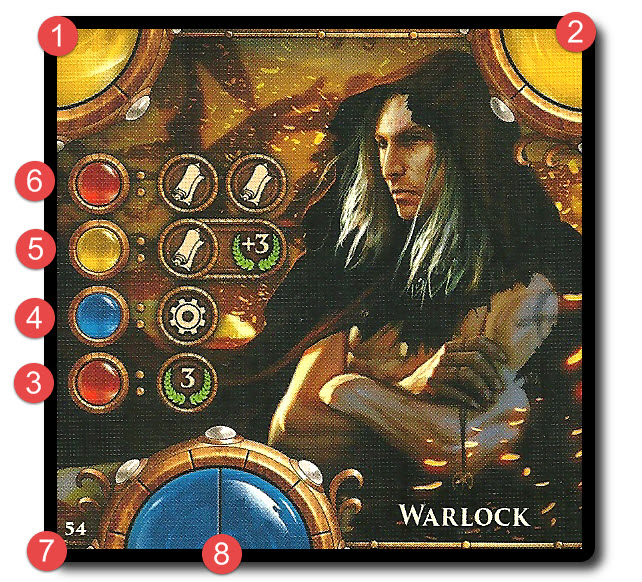
- Colored Section: supports cards above it
- Colored Section: supports cards above it
- First Level Cost : Reward
- Second Level Cost : Reward
- Third Level Cost : Reward
- Fourth Level Cost: Reward
- Priority Number
- Colored Section: connects to cards below it
Law Cards
Viceroy has very little in the way of rules. Game play is straightforward and everything a player needs to know is either on a card or summarized on their Player screen. The Law cards alter the rules a bit, changing how a player can win the game. Each Law card will either give the player a one time bonus which must be resolved when the played or additional ways to earn points at the end of the game. Law cards are played directly to the player’s growing pyramid, providing not only a brief or long-term advantage, but additional support for their growing power.
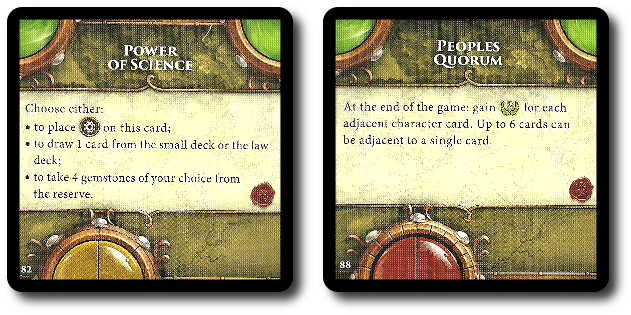
Tokens and Favors
Viceroy makes use of tokens in the game to represent different resources and bonuses to be calculated when the game is over. Each token type is summarized here.
Gemstone Tokens and Infinite Gemstones
Gemstones come in 4 different colors and serve as currency in the game. Players will use Gemstone tokens to buy cards during an auction and then again when adding cards to their pyramid. Gemstones are also a limited resource. There are 4 of each colored Gemstone per player in the game, making it fairly easy to determine how many of any one particular color type may or may not be available. It’s also worth noting that additional detail has gone into the tokens and colors to help players who are color blind.
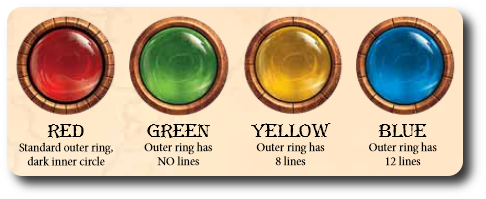
Infinite Gemstones are not a token, but they do require 1 Gemstone token to use. Infinite Gemstones are provided by a pyramid card. Infinite Gemstones provide the player 1 reusable Gemstone token that is never placed back in the Gemstone reserve, but it can only be used during the Development phase (cannot use it during auctions) and only once per round.
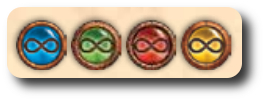
Defense/Attack Tokens
These tokens are double-sided. On one side is an image of a shield. This represents Defense. Defense tokens are kept on a player’s card located on their pyramid and there it will remain until the end of the game. The Defense token is used to score points and to defend against attacks during final scoring that might reduce the player’s total points.
Attack tokens are on the other side of the Defense token and have an image of a sword. Attack tokens are kept behind the Player screen until used. A player can spend the Attack token during the Auction phase to claim any 1 card without fear of being stopped or they can save it until the end of the game to penalize their opponents.

Magic/Science Tokens
These tokens are also double-sided. On one side is an image of a scroll. This represents Magic. Magic tokens are kept on a player’s card located on their pyramid and there it will remain until the end of the game. Magic tokens are used during the end of the game for scoring points.
Science tokens are on the other side of the Magic token and have an image of a gear. Science tokens remain attached to a pyramid card and allow the player to draw additional Gemstones. They are also used during the end of the game to provide bonus points.

Power Points
Power Point tokens list a number value that is added to the player’s final score. Power Point tokens are placed on cards on the pyramid. Unlike Gemstone tokens, players can make “change” using the Power Point token values to trade in two or more for a larger valued token.

Bonus Tokens
Bonus tokens will give bonus points for either Magic or completed colored circles on the player’s pyramid. These bonus points are applied to the total number of tokens or circles, meaning they do not provide any points unless what they are providing a bonus for is present.

Of Influence and Dominance
Viceroy is played in rounds for a total of 12 rounds in a single game or until the large Character deck has been exhausted. Whichever comes first. Each round is divided into 2 phases. There is no turn order sequence to follow. Players take simultaneous actions when everyone is ready. A typical round of game play is summarized here.
Auction Phase
The first phase of each round is an auction. For sale are the Character cards in the Auction row. Any card in the Auction row can be purchased, be it below or above the Auction row. The price to purchase a card is 1 Gemstone token that matches the color of the Auction card’s depicted Gemstone. Dirt cheap, right? Hold your horses. There’s a catch, of course.
After each player has reviewed the Auction row, they return to their Player screen and privately select 1 Gemstone token that matches the color of the Auction card that has the Character card they want to purchase. The player can also elect to not use any Gemstone, thus passing in the auction or they can use the Attack token. Once everyone has said they are ready, each player holds their hand out in a fist, hiding whatever they may or may not be holding. On the count of “3”, each player then reveals what they selected.
- If a player uses an Attack token, they place their Attack token back in the Defense/Attack token reserve and select any 1 Character card they like, placing it in their hand. This happens before the other players who played a Gemstone resolve their auction.
- If only 1 player selects a certain Gemstone color, they place their Gemstone in the Gemstone reserve and take the Character card into their hand. If there are 2 Character cards attached to the Auction card (above and below the Auction card), the player selects 1 of the 2 to take, not both.
- If 2 or more players select the same Gemstone color and there is only 1 Character card, all players lose their Gemstone token to the Gemstone reserve and receive nothing. However, if 2 players show the same Gemstone token color and there are 2 Character cards attached to Auction card, the players can decide which Character cards are taken, losing the Gemstone token as normal. If they cannot decide, then they get nothing.
- If a player reveals no token, they are passing. Passing an auction costs the player nothing, but they cannot participate any further during this phase of the round. The player take 3 Gemstone tokens from the Gemstone reserve of their choice, plus 1 additional token for every Science token they have on their pyramid. These Gemstones are placed behind the Player screen.
If a player was unable to claim a Character card and did not pass, a second auction takes place. If there are still players who have not passed or claimed a Character card after the second auction a third and final auction is held. Character cards are not drawn to replace taken Character cards. After the third auction, any player who had not yet taken a Character card or passed is forced to pass, taking 3 Gemstone tokens from the Gemstone reserve of their choice, plus 1 additional token for every Science token they have on their pyramid. These Gemstones are placed behind the Player screen.
The Auction row is now cleaned up. Any Character cards above the Auction row are discarded and removed from the game. Any Character cards below the Auction row are moved above the Auction row (following the Auction card arrows). Four Character cards are then drawn and placed below the Auction row. If the large Character deck is now exhausted after having refilled the bottom Auction row, this will be the last round of the game.
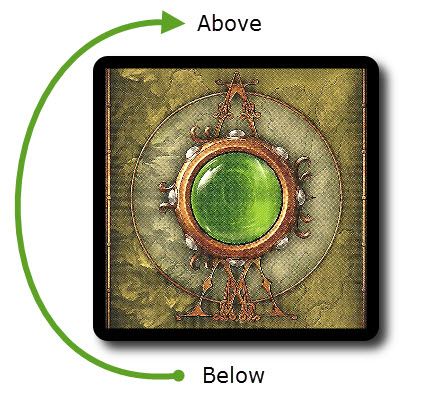
Development Phase
During this phase, players will have an opportunity to add to their pyramid 3 times. All players now privately select 1 card they will play and place it face-down in front of them. At the count of “3”, each player reveals their card. All cards have a Priority number. In Priority number sequence (starting with “1”, then “2”, and so on), each player will pay for their card, place it, and collect their reward. Any card the player has in their hand can be used, but there are 2 mandatory rules the players need to follow. A player can also elect to pass. If they do, they cannot participate for the duration of the phase and no Gemstone tokens are collected. If a player does not want to pass, but has cards, they can discard 1 card to receive 2 Gemstone tokens from the Gemstone reserve.
Rule 1: Cards Must Always Have a Solid Foundation
The lowest level cards on the player’s pyramid are the base. A player can play as many cards as they like to the left and right of the first Character card they placed during game setup. Building upon the base and adding levels requires a bit more thought. Every card must have 2 other cards in the level below it as its base. The game rules referred to the card as “resting” on the two cards below it. Gemstone circle colors need not match. In this way, the player will be building a pyramid-like formation with their cards, with the lowest-most level having the most cards and each level above it with slightly fewer cards.
Rule 2: Pay to Place Cards and Get Rewards
If the card can be supported by 2 cards in the level below it, the player pays 1 or more Gemstones to place it. Playing cards on the lowest level only costs the player 1 Gemstone. Playing a card on the second level costs the player the second and first Gemstone, and so on. When a card is placed on the fifth and highest level, the player must pay the Gemstone cost of all the levels below it and pay the top most Gemstone token one additional time. Expensive!
Rewards
When the card is correctly played, the player collects their reward. Each card lists the reward it provides based on the level it was placed. If the Character card was built on the fifth level, the player receives the rewards for the first 3 levels or 15 Power Points. The Player screen summarizes each of the icons used on the cards, making it easy for a player to quickly determine what a card will provide before it’s played. Rewards include additional Character cards from the smaller Character deck, Gemstones, Law cards, Defense/Attack tokens, Magic/Science tokens, Power Points, and Bonus stones. Some cards will even give the player an infinite Gemstone token that is attached to the card and never goes away.
If a Law card was played, it’s immediately resolved. If the Law card requires the player to make a choice, play a card, or collect more tokens, they do so but leave the Law card where it’s in their pyramid. If the Law card provides additional ways to score at the end of the game, it cannot be resolved until the end of the game.
Finally, if a player was able to create a complete Gemstone circle of a single color when they placed their card, they collect a Gemstone of the same color from the Gemstone reserve.
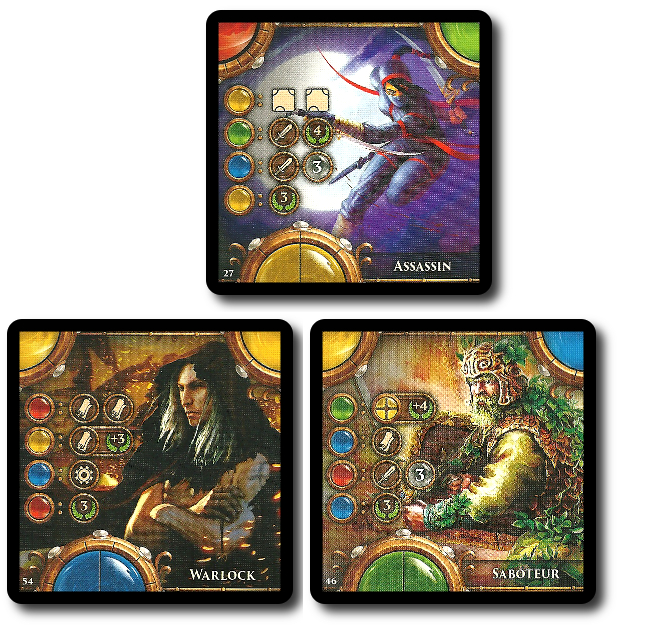
A complete yellow Gemstone circle (top card and bottom 2 cards)
The Development phase continues a total of 3 times as described.
Ending the Game and Final Scoring
The game ends after the Development phase is completed on the twelfth and final round or the players or at the end of the round when the last of the large Character deck cards were used to fill the Auction row. It’s now time to determine each player’s score. The Score pad can be used or players can just go down the list in the game rule book, adding the point values in a column. Points are calculated for the following:
- 1 point is awarded for every single-colored Gemstone circle in the player’s pyramid. If the player has any Bonus tokens for single-color Gemstone circles, they are added to the total, not to each single-color Gemstone circle.
- For every infinite Gemstone the player has on their pyramid, they receive a number of points equal to its row level. Any Bonus tokens for infinite Gemstones are also added.
- Additional points are given by Law cards that award Power Points.
- Power Point token values are added to the player’s total.
- Total Magic tokens with Bonus tokens for Magic are added.
- 12 points for every complete set of tokens. A complete set is 1 Defense token, 1 Science token, and 1 Magic token.
- Reduce all opponents’ total points by -4 for every Attack token the player had not used. Defense tokens block Attack tokens using a 1:1 ratio.
After all the math is done, the player with the highest score wins the game.
Game Variants
Two game variants are provided in the rules giving players some options when it comes to ways to play the game. Each are summarized here.
Ruler of One
Viceroy can be played as a solitaire game. The player will go against a “virtual player” who only acts during the Auction phase. The virtual opponent’s bid is determined by randomly selecting 1 Gemstone from those not used. If there is no conflict, the player wins their selected card. The player cannot lose the game. Instead, the goal is to attempt to make as many points as possible, record it, and then play the game again in an attempt to beat your high score.
Virtual Players for a Group
If playing with 2 or 3 players, 1 or more virtual players can be added to the mix as long as the total number of players (real and virtual) does not exceed “4”. Virtual players are only active during the Auction phase. Like the Solitaire game variant, the virtual player’s Auction choice is based on a randomly selected Gemstone token. Players build their pyramid as normal and only the “real” players score points at the end of the game.
To learn more about Viceroy, visit the game’s web page.
Final Word
The Child Geeks quickly learned how to play the game and got to it, showing good use of Gemstone tokens and building their pyramids. About halfway through, they had problems. They ran out of Gemstone tokens and their pyramids weren’t growing. According to one Child Geek, “I didn’t realize you could run out of Gemstones so quickly. Makes it hard to build a big pyramid.” Another Child Geek said, “I was liking the game up until I couldn’t do anything.” Viceroy began to frustrate the Child Geeks and then anger them. This is not a game that cares one bit for the player if they are foolish enough to not watch after their resources. This spurred some Child Geeks to play better and smarter, which they did. The other Child Geeks took this as a sign that the game was too hard or not fun. According to one of these Child Geeks, “I don’t want to play this game anymore because it’s impossible to get the cards you want.” After several games, the Child Geek crowd was more or less split down the middle. Those Child Geeks who loved playing games and had played many in the past found they really enjoyed Viceroy. The non-gamer Child Geeks and emerging casual gamers found Viceroy to be more than what they wanted. Age had nothing to do with the final vote. A Child Geek liked the game or didn’t purely on their perceived idea of “fun” when it came to games. Child Geeks who thought fun meant a challenging experience voted to approve Viceroy, while the other Child Geeks did not.
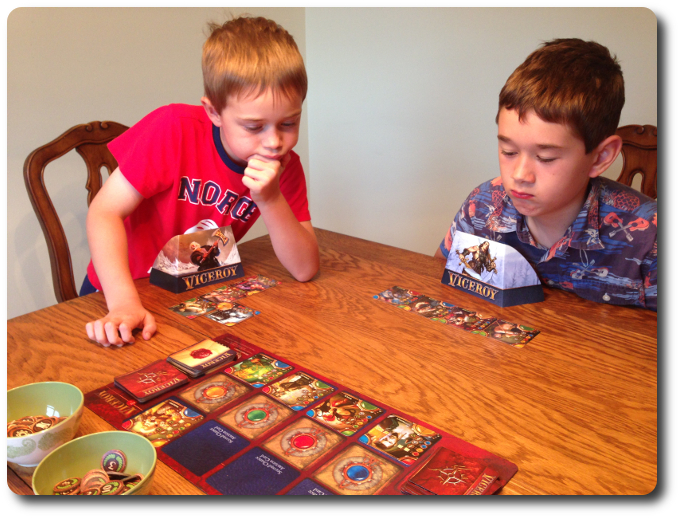
The Child Geeks review the Auction row, pondering how best to spend their Gemstone tokens…
The Parent Geeks also quickly learned how to play the game and fell into the same trap as their Child Geeks. That is, the Parent Geeks didn’t pay attention to the subtle use of resources and how the cards interacted. They quickly found themselves in corners and they worked very hard to get out of them. Unlike the Child Geeks, all the Parent Geeks played the game with a smile. According to one Parent Geek, “I really like this. It’s strangely hard and yet easy at the same time. It’s difficult to put into words.” Another Parent Geek said, “I kept asking if this was all there was to the game. I was buying cards without a problem and adding them. Then it hit me. OH, NO! I wasn’t going to score any points!” The Parent Geeks really enjoyed Viceroy and voted to approve it.
The Gamer Geeks kept scratching their heads while playing Viceroy, too. It was only when the game was scored that they all went “OH! NOW I SEE!” and demanded another game. Viceroy is not about buying cards and building a pyramid. It’s about buying the right cards and placing them at the right time next to the previously placed card you placed at the right time, with each build expanding power and points. You don’t really see that until the end of the game. Now knowing how everything worked, the Gamer Geeks played a much stronger game and the Auction took on a new level of focus. According to one Gamer Geek, “I didn’t get this game until I lost it. Then my eyes were open and I knew exactly what I needed to do next time.” Another Gamer Geek said, “This is a clever game. I can see how I can score lots of points, but what I really need to do is score points and create a way for me to load my pyramid with bonuses. Lots to think about!” All the Gamer Geeks voted to approve Viceroy, finding it to be a game that made them think, challenged their ideas, and rewarded good plays.

A Gamer Geek expresses his disappointment regarding a certain color not being in the right place…
Viceroy is sometimes positioned as a Fantasy game. It’s not. The only thing fanciful about it is the artwork that depicts characters you would most certainly expect to see in a fantasy world. But that’s it. There is no theme in the game, which is not a bad thing by any means, but don’t go looking to build a fantasy kingdom when playing Viceroy. What you are really building is a little machine that continues to make Gemstones and generate points. That doesn’t require a theme to be entertaining.
I cannot recommend enough the use of the virtual players when playing a 2 or 3-player game. The Auction phase is somewhat bland without a real threat of not being able to get the cards you want and losing a Gemstone in the process. The virtual players add the very real possibility that a player might get skunked, while not using them almost guarantees a player will get something of value. Of course, lack of a virtual player makes for a less stressful game, but where’s the fun in that?
You cannot play Viceroy once and form an opinion of it that is worthwhile. It’s not a game that shows you what it’s all about during your first or even second gaming session. Each time I played the game I saw a bit more, appreciated it on a deeper level, and was astounded at how bad I was at it. I often hear the question, “Is this it? Is this all there is to the game?” A fair question since the game play is very easy. It’s only when the player scores their pyramid that they come to understand how their efforts impacted the results. The final scoring is where the proverbial rubber meets the road and should be the only thing a player is thinking about during the game. Individual card plays are but a single step up the pyramid. If the player falters or backtracks, the game will be lost.
I am most pleased with Viceroy. I was skeptical at first based on all the hype it was receiving, but I see now that much of it is warranted. It’s easy to teach, fast to play, and devilishly hard at times to beat. Its multiple levels of resource management both in the short and longer-term, scalable point ladder, and seemingly unlimited replay value makes Viceroy a real treat. Do give this game a try when time permits.
This game was given to Father Geek as a review copy. Father Geek was not paid, bribed, wined, dined, or threatened in vain hopes of influencing this review. Such is the statuesque and legendary integrity of Father Geek.



